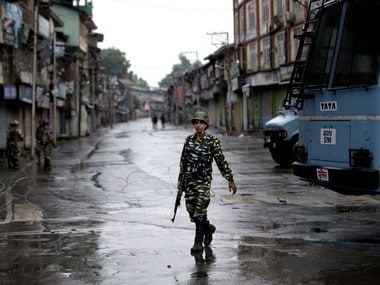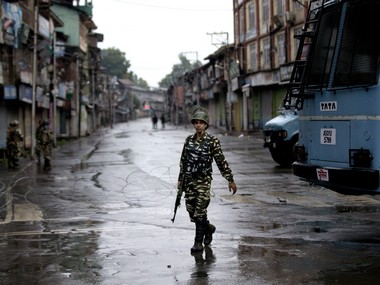For weeks after his photographs appeared on Facebook in December, 2017, the teenage boy wearing a scruffy beard and baseball cap, a light machine gun cradled awkwardly in his arms, was the living image of jihadi chic for Kashmir’s young Islamists. In 2016, inspired by slain jihad commander Burhan Wani’s social media posts, Umer Fayaz Lone dropped out of his commerce studies at the Higher Secondary School in Lurgam; inside a year, he was leading the Hizb-ul-Mujahideen in southern Kashmir’s Tral. Lone was killed by police this weekend: the first jihadist leader to die this year; among the last of the Facebook jihadists recruited by Wani to live that long. In 2014, around the time this new cohort of Kashmiri jihadists began to form, police surrounded the village of Lilhar, searching for terrorists. Hundreds of local residents began throwing stones at police, to help the terrorists escape. A year later, thousands assembled for the funeral rites of Lashkar-e-Taiba jihadist Abdul Rehman, also known as Abu Qasim. [caption id=“attachment_7370321” align=“alignleft” width=“380”]  File image of a paramilitary soldier patrolling a street in Srinagar. AP[/caption] Through the great tidal wave of protest which swept over Kashmir in 2016, following Wani’s killing, armies of protestors came out in support of jihadists. In many villages and small towns, the Indian state disappeared, and Pakistan’s flag was hoisted over schools. As police surrounded the village of Seer in search of Lone in the weekend, dozens of young people gathered to throw stones—the first such incident since Article 370 was de-operationalised, and New Delhi set about building what it says will be a New Kashmir. The young Islamists at Seer were easily shooed away—but the protest has underlined disturbing questions. In 2019, violence levels fell, for the first time since Prime Minister Narendra Modi took office. That raised hopes that peace could lie in the future. Past Indian prime ministers have, however, discovered that, when it comes to Kashmir, there’s an exceedingly thin line between hope and self-delusion. From classified data obtained by Firstpost, it’s possible to put the fall in violence last year in its real context—thus flagging important issues of concern, and allowing for informed speculation on which way events might head.
- Is terrorism in Kashmir being crushed?
New Delhi isn’t lying when it claims Kashmir had a relatively peaceful year, belying fears that the de-operationalisation of Article 370 would set the Valley on fire. Killings of civilians have fallen from 114, in 2018, to 50 in 2019. The number of civilians killed in police firing on rioting protestors fell from 59 to six. The number of security force personnel killed fell from 91 to 80. Every index of terrorist violence, from grenade attacks to firing, showed a sharp fall—except strikes involving improvised explosive devices, which showed a marginal uptick. This is all good news. But then, there’s the buts. In past years, the winter has been the offensive season for Indian forces operating inside Kashmir, as opposed to on the Line of Control, since terrorists can’t easily escape villages to hide out in the hills and forests. This year, though, operations have been sharply curtailed: in all of December, not a single terrorist was killed. The number of terrorists killed overall also fell, from 257 to 157. There are some other worrying signs. The ratio of Indian forces killed to terrorists killed declined, from almost 3:1 to below 2:1 now. This is an important counter-insurgency index to measure the relative success of the combatants—and its fall is not good news. Put simply, this could mean terrorists are just biding their time—taking an easy swipe when they can, and sitting back in rural safe havens when danger lurks. Prior to 2016, killings of terrorists were also low. In retrospect, though, it’s clear they were present in numbers, using the quiet to recruit and propagandise while the government was lulled into a false sense of security.
- Is the fall in violence last year a harbinger of the future?
Perhaps. Perhaps not. Home Minister Amit Shah says there is “total normalcy” in Kashmir—but then, his predecessor Shivraj Patel declared normalcy in 2004, while his predecessor LK Advani deemed the India-Pakistan peace process irreversible. The truth is, violence levels in Kashmir have ebbed and flowed. The figures for 2019, low as they are, are much higher than in the period 2010-2014. Earlier, violence levels fell sharply after 1994 and again after 2001. Each time, policymakers hoped this was the outcome of changes in Pakistan’s thinking or fatigue among insurgents. Each time, their hopes were belied. This time, of course, things might be different: the Balakote attacks, for example, might have deterred Pakistan from continuing with the Kashmir jihad, as some contend, just as the near-war of 2000-2001 led General Pervez Musharraf to deescalate, fearing catastrophe. But, again, Pakistan’s strategic establishment might just believe that India, facing an economic crisis and sharp constraints on defence expenditure, isn’t itching for a fight, either. That could lead it to consider escalation. The big take away: The ISI still holds the keys to violence in Kashmir. The question is whether Pakistan has been deterred from using its tools—or not.
- Is infiltration across the Line of Control continuing?
Estimating infiltration is a notoriously difficult business: there’s just no reliable way of gauging how many jihadists cross the Line of Control. In 2019, India estimates 202 jihadists crossed the Line of Control. That’s a sharp fall from 323 in 2018, and 406 in 2017. There’s an interesting pattern, to these figures though: as the Islamist-led street violence in Kashmir escalated from 2010, infiltration fell, almost as if the ISI dials the violence up and down, to suit its political ends. Even after the de-escalation of hostilities on the Line of Control following the ceasefire in 2003, estimated annual infiltration stood in the 500. Then, after large-scale violence began in 2010, it halved—only to rise again in 2017, when the uprising that followed the killing of jihadist icon Burhan Wani was crushed. Some believe the ISI has dialled back infiltration because India signalled, through the attack on Balakote, that it was willing to risk war to punish large-scale acts of terrorism. That’s possible—though it bears mention that the Government itself says over 50 terrorists have crossed the Line of Control since Article 370 was de-operationalised, a fact which doesn’t sit well with this conjecture. The second possibility is that Pakistan Army chief General Qamar Javed Bajwa is content to bide his time, while India faces the heat of international and domestic pressure for its Kashmir policies. In the meanwhile, Islamabad has begun to normalise its relationship with the United States, which recently reopened officer training for Pakistan Army officers. Pakistan has also emerged as a key ally for that country in Iran and Afghanistan, and its military has begun to heal fractures with domestic opposition parties. None of this, to sum up, is good news for India: a Pakistan Army not facing international pressure, and free from domestic challenges, is one that much more likely to look east.
- Are Kashmir’s Islamist-led street protests stilling?
There wasn’t a single fatality in clashes between protestors and police in December—and just four in the whole year, down from 48 in 2018 (Two more protestors were killed this year, shot dead while throwing stones at security force personnel engaged in counter-terrorism operations). This may have something to do with the extraordinarily high levels of arrests on terrorism-related crimes, targeting many alleged involved in organising these clashes. The 962 arrests in 2019 are the highest, incredibly, since 1995—though it bears mention arrests have been increasing over the years, with the Jammu and Kashmir Police becoming more reliant on criminal-law processes than extra-judicial killings and torture. The low death toll of civilian protestors this year—the lowest since 2014—is welcome. However, it’s worth noting that there were low fatalities in several previous years, like 2011-2012, and 2014-2015, only for the peace to be swept aside by gargantuan tides of street protests. For security planners, the real fear is this: in the absence of political protests, young Islamists could turn to terrorism. Terrorist groups like Al Qaeda have already called on Kashmiri jihadists to turn their attention from a losing war of attrition inside the state to targeting Indian cities and economic infrastructure. Except for professional astrologers, no-one’s going to risk saying whether that will happen or not—but its certainly within the realm of possibility, since Kashmiri jihadists have staged successful attacks in Delhi, Gujarat and in other places.
- Is Kashmir’s politics likely to normalise?
Prior to the imposition of curfews and the arrests of leaders, 2019 was an extraordinarily active year: the National Conference, Peoples Democratic Party, Indian National Congress all held record numbers of political rallies, perhaps in anticipation of an election. Irrespective of how popular or unpopular these parties and their leaders might be, the figures show they had substantial organisation clout and cadre. Also significant: even as rallies by pro-India political parties was increasing through 2019, secessionist parties like the All Parties Hurriyat Conference were showing a diminishing ability to mobilise even prior to the imposition of restrictions. There were just 31 protests by secessionists, down from 59 in 2018. These are all obviously a good thing for democracy. But the question now is will the parties in Kashmir have survived the shocks administered at the end of 2019? The worst-case scenario for India is that it could have sacrificed the democratic revival of early 2019, without there being legitimate political actors to take their place. In the absence of legitimate leaders, after all, the field is open to the one organised force still on the ground—the jihadists, and their Islamist supporters.


)

)
)
)
)
)
)
)
)



